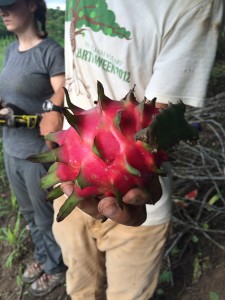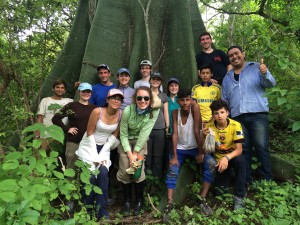Over spring break, I joined a group of seven students from the College of William & Mary on the Branch Out service trip, TREE. We loaded onto an airplane and headed off to the dry forest in Ecuador to plant some trees. Clarification #1: The dry forest is different than the rainforest. The dry forest is located on the western coast of Ecuador whereas the rainforest circles around to include the eastern region of the country. Unlike the rainforest, known for its constant wet conditions, the dry forest, on the pacific coast, has both a rainy and a dry season. When we went, it was the rainy season — green, lush, rainy and roughly 80°F. In the dry season, from June to December, the land appears dead with no rain. This dry season tricks many people who see the forest as “dead” anyway and therefore cut down many of the trees. Now, less than 25 percent of the dry forest is left, resulting in erosion and mudslides as well as the destruction of one of the most bio-diverse habitats on the planet.
Dedicated to preserving the dry forest, California residents Lucas and Jasper Oshun founded Global Student Embassy (GSE) in 2008. We know the story all too well where a white man comes into another community, finds a problem and tries to fix it, but as I learned more about GSE, I began to see why this organization is different.
Lucas partnered up with Ecuadorian science teacher, Mancho, and the two of them work on a program where students are the core labor and funding that supports this reforestation project. Lucas has set up GSE programs and eco-clubs throughout the United States especially in high schools and colleges in California. Mancho started high school eco-clubs in which Ecuadorian students prepare for reforestation throughout the year and then plant trees with American students in our springtime. Some of these Ecuadorian “eco-club” teens are even given the opportunity to visit the United States.

When we arrived in the beaches of San Clemente on the Ecuadorian coast, some of the first faces to greet us were those of Luis, Alvaro, Fiorella, Rolando, Evelyn and Christian — all Ecuadorian students and interns. Country boundaries rapidly faded as we traded a Salsa class for the “Cotton-Eye Joe” dance, exchanged language lessons and compared environmental actions.
Together, we planted over 500 trees in just three days in Bahia, Ecuador. For the first time, I felt the lumpy green skin of the Ceibo tree and ate a bright pink dragon fruit straight off the branch. The mosquitos swarmed and our arms carrying the fifty-pound seedling boxes ached. There were some near-fainting experiences and the harsh sunlight reminded us that Ecuador is on the equator. Yet the feeling of rich soil in-between my fingers, the Spanish jokes and the look of the farmers after they saw our hard work were all I needed to keep planting.
On the last days of the trip we left the bioluminescent-watered, pink-sea-shelled Bahia coast, and stayed in the old Andes town of Cuenca. There, I learned about the various groups of indigenous people in Ecuador like the Quechuas who wear two braids, a velvet skirt and dominate the traditional medicine corner of the market. We explored the enchanted Cajas National Park with “Quinoa” trees the color of a red crepe myrtles and with waters so clean we drank out of them.

On the last days we reflected on the trip: the culture, the nature, the friends. All of the immense beauty humbled me and reminded me of my small size in the immense, dynamic and essential forests of Ecuador.


[…] Read the full story. […]